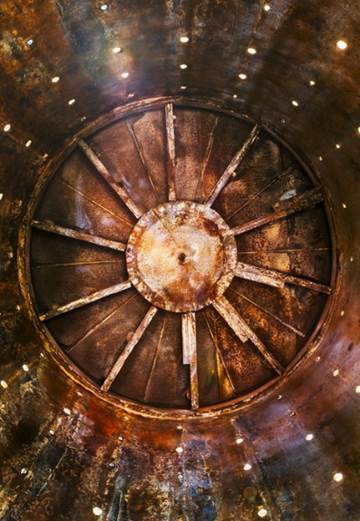Rusted cans, discarded bolts, spiraling culverts and other rusted metals scattered across a desert may seem to some people pretty iffy stuff to make up the sort of art exhibit they’d care to come see.
Earth-scape art photographer Ted Rigoni would like his photos of rusty, pioneer cast-offs in the Mojave Desert to change a few minds about that.
”Oxidized,” a collection of his contemporary art photographs on display until Jan. 6 in the Community Center Gallery at 910 Ninth St. SE, offers an intimate encounter with all sorts of metal objects left behind by would-be farmers, ranchers, miners, entrepreneurs and other dreamers as they were making their way to California over the punishing Mojave in the 1800s and the early 1900s.
Some of them made it there, some didn’t.
“What remains after we leave?” Rigoni asks. “In this particular case, it’s the rusted metal. What we have in a sense, then, are dreams abandoned, or dreams lost, or the remainders of those dreams. So, my exhibition isn’t so much about the people. It’s more about what they’ve left, what remains once they’re gone.”
And, a natural followup question: What are people 50 or 100 years from now going to think about what this generation leaves behind? How will they look at what we’re doing now, or what we now see?
“Are they going to think we were doing fairly well, or will it be, ‘Oh, my God, I can’t believe people were having those issues back then,’ and now we’ve taken care of those problems,” Rigoni said.
The exhibit offers few hints to its deeper meaning.
That’s deliberate, Rigoni said. “Oxidized” is not a passive display of typical photographs. It asks the people who come to see it to engage with it.
Indeed, one of the first things a visitor picks up on is the absence of any frame of reference for the images. Not only will they not know where they were taken, but, outside of a small selection of photographs, they won’t know how large what they are looking at is, and in some cases, they won’t even know what they are looking at.
“My hope is that it’s going to be something that makes you wonder, ‘Is that a foot square in real life, or is it 10 feet or 20 feet square,’ or to ask, ‘What was that? Was that a metal drum? A cylinder? Was that wire or cable?’… I’ve intentionally done that because I want people to look at the work and really form their own narratives,” Rigoni said.
In the last three years, Rigoni estimates, he’s made 25 or more excursions into the Mojave just to look at metal, and found stand-alones like tubs and parts of abandoned mining refineries.
“When I find something that used to spin and used to have mercury injected — if you know anything about that, gold and mercury have an affinity for each other — that’s how they used to separate them. And I look at that and say, ‘This used to spin, and the noise that it must have made, and the dust and the smoke that used to come out of here and the people who used to work this out in the desert where it’s 120 degrees, how did they do this, how did they survive?’”
In a place called Golden Dome, Rigoni said, he’s found abandoned materials he simply had to climb into.
“I’m very careful about what I do, but if I don’t push the envelope, then I am not being true to myself, and all I’m doing is taking snapshots at 5 feet, which anybody can do, which we all do. As a photographer, you have to go beyond that. Otherwise, why would someone be interested in what it is that I see?”
“Oxidized” is not just an exhibit — it’s an extension of Rigoni himself. From boyhood on, he said, he has been in love with geometric forms and their relationships with other geometric forms.
Growing up a stone’s throw from the Mojave and its blazing floor of metal artifacts, Rigoni said, provided him plenty of grist to feed this fascination, as did his 39-year career as a civil engineer in Orange County.
His father, he said, owned a real estate business in the 1970s and 1980s, and on weekends would take his family out to the desert, which is so close to where Ted grew up that he could, and still can, easily get to it via dirt roads or paths.
“My dad was pretty much one of those people who didn’t want anyone telling him what to do, although of course, he followed the laws. He tried to be an entrepreneur, and real estate was his way of escaping, getting out, getting in touch with the land. I must have inherited some of that characteristic as a civil engineer for almost 40 years, and then moving onto this,” Rigoni said.
Now in his mid 60s and retired, Rigoni feels blessed to have the opportunity to indulge his lifelong loves and turn them into a second career, in this case as an earth-scape art photographer.
Each person, he said, has to pursue what it is that they’re compelled to follow and do.
“For me, everything, whether it’s man-made or nature-based, there are so many forms and shapes in nature, and just looking at those and capturing those, it’s really cool stuff,” Rigoni said.
This exhibit is coordinated through the City of Auburn’s Parks, Arts and Recreation Department with the support of the Auburn Arts Commission.


